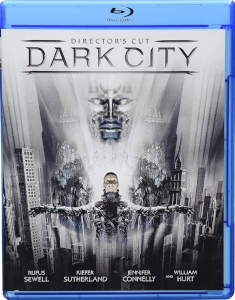“Dark City” (1998) perhaps came out just before the window when it would’ve been a mainstream smash, since “The Matrix” achieved that status one year later. But it has always had cult appeal, starting with Roger Ebert’s famous championing of the film; it was his No. 1 pick for 1998, one of only two sci-fi pictures to earn that honor from him (2002’s “Minority Report” is the other).
An out-of-time noir
My first impression of what makes director/co-writer Alex Proyas’ film great is the production design, led by George Liddle and Patrick Tatopoulos. “Dark City” is like “Batman’s” Gotham as an out-of-time noir, except no “Batman” production has achieved this level of beauty.
The cars are mid-century-ish and people read print newspapers, but there are also “automats,” where you select your food without bothering with waiters or cashiers (not a huge technological leap, but still a nod to a futuristic time). I love that this isn’t just a stylistic choice, like it is on “Gotham”; there’s an in-story reason for it.

“Dark City” (1998)
Director: Alex Proyas
Writers: Alex Proyas, Lem Dobbs, David S. Goyer
Stars: Rufus Sewell, Kiefer Sutherland, Jennifer Connelly
As the title suggests, there is no sunlight in this metropolis — although Rufus Sewell’s John has memories of wonderful childhoods at sunny Shell Beach. At first, I didn’t even think about this; I figured all the action takes place at night, in wonderful noir settings like run-down hotels and streets that seem wet even though we don’t see rain. I began to think about the perpetual darkness at the same rate John does.
As I began to grasp the story – which initially seems disjointed and perhaps out of order (and I watched the theatrical cut, which is the hand-holding version) – I became engrossed. Once it clicks into place about 30 minutes in, the narrative meshes nicely with the striking images: an alley of brick that leads to a dead end, or a door at the end of a hallway that leads to open air and a long drop, or buildings that move and reform during the Strangers’ nightly “tuning.”
Similar imagery would later be seen in “Inception” and “Doctor Strange”; it totally holds up, and it reminds me that “Dark City” – although a cult film – is an expensive production.
A sardonic vibe
Much like in “The Fugitive,” John might consider trying his luck by stepping out the open-air doorway because he’s being pursued on multiple fronts – first by Inspector Bumstead (William Hurt, who is also in 1998’s not-as-good “Lost in Space”), who thinks John is a murderer, and then by the Strangers, white-skinned corpse-like people who framed him.
Hurt definitely knows what kind of movie he is in, pushing a sardonic vibe, as does everyone else. Jennifer Connelly is femme fatale Emma, who sings lounge songs that are sad and sexy. Kiefer Sutherland is a nebbish who works for the Strangers and speaks in a halting voice.

The Strangers famously inspired the Gentlemen from the “Buffy” episode “Hush” a few years later, but they don’t always float and they do speak, and they rob people of memories instead of voices. They morph from vague threats into fascinating sci-fi villains once we learn their plan: They have created a city that draws from various periods of Earth history, and moved humans there to study them.
The “Valerian and Laureline” story “On the False Earths” (1977) also uses this premise, although it’s broad enough that I imagine “Dark City” writers Proyas, Lem Dobbs and David S. Goyer came to it on their own.
“Dark City” is thematically rich, a broad commentary on the faults of collectivism and the value of individuality. This gives substance to go with the style, but … my god, the style. And the striking images are used to tell the story; for example, John and the inspector punching a hole in a brick wall and finding empty space beyond. You can bring your own subtext to moments such as this, but the design of “Dark City” is for all to enjoy.

